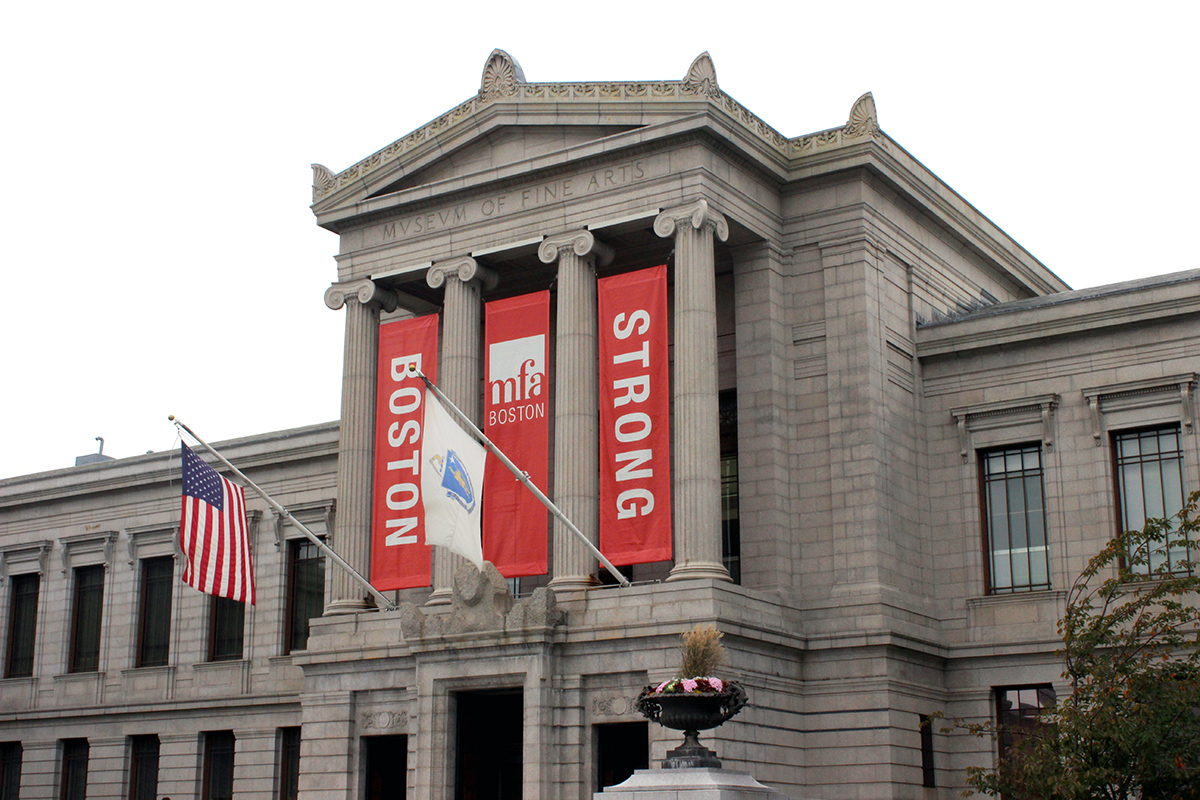Follow Friday: The Museum of Fine Arts

Museum of Fine Arts / Photo by Olga Khvan
Follow Friday, At a Glance
Connect with the MFA on social media:
![]() Facebook
Facebook![]() Twitter
Twitter![]() Instagram
Instagram![]() YouTube
YouTube![]() Flickr
Flickr![]() Pinterest
Pinterest![]() Google+
Google+
One of Boston’s most highly regarded cultural institutions, the Museum of Fine Arts, has been building a great reputation in recent years, becoming a more open and active part of the community.
Part of this is thanks to their adoption of social media, which has been pretty on-point lately. When fake news site The Onion published a story about the MFA called “Shitty Museum Doesn’t Even Have a Mona Lisa,” the MFA took it in stride and even tweeted about it, plugging an upcoming da Vinci exhibit in the process.
After reaching out to the New England Aquarium for last week’s Follow Friday, I was surprised to find that the NEAQ has its own editorial team. Equally surprising: all of the MFA’s social media channels are managed by one person: Christine Stine. Stine, who has been with the MFA since 2009, is the woman behind the MFA’s great Facebook, Twitter, Instagram, and other social media accounts. She was also the project manager for the MFA’s very first crowdsourced exhibit “Boston Loves Impressionism,” which was a runaway hit this spring.
Here, Stine shares how she uses social media to keep MFA fans engaged, informed, and all-around amused.
How many people run the MFA’s various social media accounts? How do you manage all of them?
I’ve managed social media for the MFA for the last five years—when I arrived at the museum in 2009, there was only a newly created Facebook page with a couple hundred fans. Since then I’ve created a multi-channel social media program that includes Facebook, Twitter, Instagram, Google+, Pinterest, and YouTube. We have a one-person social media team—I manage strategy, content, and execution. I create an editorial calendar each month, but I’m also opportunistic, sharing new stories, live events, behind-the-scenes snapshots, or artworks that relate to current events in Boston.
What are the goals for the MFA on social media, and where does your content usually come from?
Our goals for the MFA’s social media channels are to engage people through entertaining content and to encourage conversations about art. Our content is as wide ranging as the contents of the museum—we share stories about artworks in the collection, create campaigns for major exhibitions, and promote films, concerts, and educational programming. The images I share are primarily of works of art, but I’m also frequently in the galleries taking behind-the-scenes photos of a new installation, or sharing a photo taken by a museum visitor.
When you walk into a gallery, you might see a work that you have a strong emotional reaction to, another that makes you curious about how it was made and the story behind it, and another that reminds you of a current event. These are the kinds of stories I try to tell with the MFA’s social media.
I like to tell stories in the context of what’s happening in the world today. I’m continually looking for ways that the MFA can be relevant to our fans in daily life, whether that’s through sharing a portrait of Nelson Mandela on the day he passed away, or telling more lighthearted stories and posting Copley’s iconic Watson and the Shark during Shark Week, or sharing a landscape that looks like it could be an illustration of the weekend’s weather forecast.
In three words, describe the voice and tone of the MFA’s social media.
I’ve worked to develop a voice for the museum that is engaging, fun, and approachable—but still smart and informative. Our social media isn’t the didactic text you might expect, and it isn’t just a marketing tool. We’re sharing entertaining stories and encouraging real conversation.
Which social media account is the strongest channel for the museum? If you had to pick, which one is the “must-follow”?
Our Facebook page has more than 220,000 fans and gives me the opportunity to share longer form content—it is the real hub of our social media channels—but I have to admit that I love Instagram for its gorgeous photos and more casual voice.
We allow photography in most of the galleries, and many of our visitors share beautiful photos on Instagram. I select a visitor’s Instagram photo each week and feature it across our social media channels. We also partnered with Instagramers Boston to invite influential Instagramers to the museum, and I’m creating more events to involve Boston’s social media influencers and showcase their work.
.@TheOnion finally calls us out. We would like to formally apologize for not having a Mona Lisa. http://t.co/IyeQ1Rm5vm
— Museum of Fine Arts, Boston (@mfaboston) June 10, 2014
.@TheOnion readers, we hear your concerns. As a gesture of good will we will install a da Vinci exhibit next year: http://t.co/vJowECvr6R
— Museum of Fine Arts, Boston (@mfaboston) June 10, 2014
What’s the process for responding to outside news? You handled the Onion story really well, for example, and I think people appreciated the way the MFA handled the eight Nigerian works recently returned to their home country. What about when something like the Homer Simpson graffiti happens?
I wish I had an excuse to tweet to The Onion every day! The last thing I want to do on social media is respond defensively. We have an amazing community that will jump in and defend the MFA. When the museum was defaced with graffiti recently, hundreds of people voiced their outrage.
Tell me more about “Boston Loves Impressionism”—it was so popular, are there plans to do more crowdsourced exhibits?
I was the project manager for “Boston Loves Impressionism,” the Museum’s first crowdsourced exhibition. The project gave me the opportunity to give our strong community a say in what happens in the galleries and has been one of our most popular campaigns. In the future, we are thinking about different ways that more exhibitions can be interactive—both online and onsite.
What’s the weirdest, most surprising, or most outspoken feedback you’ve gotten via social media?
My favorite feedback this year came from an 11-year-old girl who recreated classic works of art by dressing up and staging scenes to imitate her favorite artworks.

Left: David Ortiz photo by Colin Steele on Flickr / Right: Portrait of a man, Roman, Imperial Period, about A.D. 250–260. via MFA Facebook
Since you’ve been with the MFA, what has been your personal favorite story to share on social media?
During last year’s World Series, we had a lot of fun matching the bearded Red Sox players with the bearded artworks at the MFA. Some of the resemblances were spot on, and it was a hit with art and baseball fans alike. Boston.com even made the pairings into a matching game—it was a great way to show how even a museum can have a sense of humor.
Responses have been edited and condensed.


